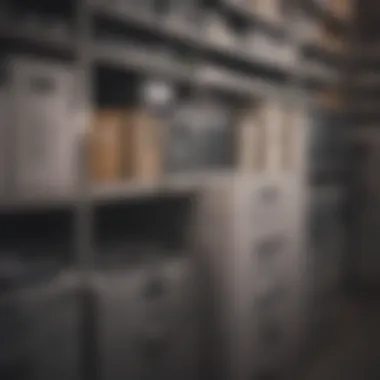Essential Tips for Streamlining Your Office Space


Intro
In today’s fast-paced work environments, maintaining an organized office is crucial. A clutter-free space not only enhances productivity but also contributes significantly to mental clarity and focus. With professionals often juggling multiple tasks, effective office organization becomes imperative.
This guide provides essential strategies for both the physical and digital aspects of office organization. It aims to streamline workspaces, making them not only functional but also aesthetically pleasing. By following these practical tips, anyone can create an efficient work routine, which will raise the overall office experience.
Trend Report
Current Trends in Office Organization
Efficient office organization is not just about decluttering; it also involves embracing innovative tools and methods that resonate with today’s work culture. Here are some trends that have gained traction:
- Minimalism: This approach focuses on reducing clutter by keeping only essential items visible. The principle is simple: fewer items mean fewer distractions.
- Digital Tools: Software applications for task management have become increasingly popular. Programs such as Trello and Asana help prioritize tasks and manage time effectively.
- Flexible Spaces: Open office layouts and adaptable workstations encourage collaboration. These spaces are often designed with mobility in mind, allowing for adjustments as work needs change.
"Organizing is a journey, not a destination. Embrace new technologies and methods that work for you."
Observing Professionals
Many professionals embrace these trends in their workspace setups. For instance, using clear storage containers promotes visibility and makes it easier to find necessary supplies. Additionally, wall-mounted shelves are used to maximize space efficiency. This is evident in various online communities, like those discussed on Reddit, where users share their office setups and organization hacks.
Sustainability in Office Management
Sustainability is becoming more significant in office organization. Many now opt for eco-friendly products, such as recycled paper and biodegradable office supplies, contributing to a more sustainable environment. This reflects a broader awareness of the ecological impact of workplace practices, which resonates well with modern values.
Key Strategies for Office Organization
Decluttering the Workspace
To kickstart the process, focus on decluttering:
- Start small. Choose one area, like your desk or a drawer.
- Decide on items to keep, discard, or donate.
- Implement a ‘one in, one out’ rule to maintain balance.
Organizing Digital Files
Digital clutter is as detrimental as physical clutter. Strategies include:
- Regularly review digital files to delete what is unnecessary.
- Use clear naming conventions for folders to enhance searchability.
- Backup files regularly to avoid data loss.
Making Use of Technology
Investing in technology can enhance organization:
- Utilize apps to manage tasks and deadlines.
- Sync calendars across devices for better time management.
- Consider automation tools to streamline repetitive tasks.
By incorporating these strategies, an office can transform into a more efficient work space, allowing for increased focus and productivity.
The Importance of Office Organization
Office organization is not merely about aesthetics; it plays a pivotal role in shaping productivity, enhancing mental clarity, and establishing a professional image. In a world where time is crucial, and distractions are everywhere, an organized workspace allows individuals to focus on their tasks with greater efficiency. As we delve into this topic, we will explore various aspects that reinforce the significance of keeping an office environment organized.
Enhancing Productivity
An organized office contributes directly to enhanced productivity. When everything has its proper place, tasks can be completed more swiftly. Key documents and resources are easily accessible, reducing the time spent searching for items. Studies show that a clutter-free environment can lead to a better work rate. Employees who work in orderly spaces often report higher motivation levels.
By implementing simple organizational strategies, such as using labeled folders or file cabinets, you can streamline your processes. This approach helps in prioritizing tasks effectively. When your workspace is structured, your actions become more systematic. Remember, disorganization multiplies time spent on minor tasks, making it essential to develop an orderly approach.
Improving Mental Clarity
Mental clarity is closely linked to the organization of your office space. A chaotic environment can lead to a chaotic mind. When clutter surrounds you, it can become overwhelming, hindering your ability to think critically and creatively. An organized office encourages focus and helps to clear the mind.
To promote mental clarity, consider adopting a minimalistic approach. This means reducing the number of items on your desk to only what is necessary. By maintaining fewer distractions, your mind can shift its focus from the surrounding noise to the tasks at hand. In essence, your workspace should support a clear thought process rather than distract from it.
Creating a Professional Image
An organized office reflects professionalism and success. It communicates that you value your work and the work of others. This is especially important in a client-facing environment. A tidy workspace not only impresses clients but also instills confidence in colleagues.


Having an organized office can enhance your reputation within the workplace. Items such as neatly arranged paperwork, clean desks, and well-organized shelves convey a sense of responsibility and attention to detail. These qualities are highly regarded in any professional setting. Ultimately, the impression you leave with a clean and orderly workspace can open doors for future opportunities.
"A tidy workspace enables a tidy mind."
Assessing Your Current Workspace
Assessing your current workspace is a vital step in the journey toward effective office organization. By taking an honest look at your environment, you can uncover areas that need improvement and identify strategies that will best suit your work habits. Understanding your workspace allows for better decisions on how to arrange, declutter, and optimize both the physical and digital aspects of your office.
Identifying Clutter Sources
One of the first steps in assessing your workspace is identifying the sources of clutter. Clutter can stem from various places, such as papers, office supplies, or even digital files. Start by observing where you accumulate unnecessary items. Ask yourself:
- Do I have stacks of paper that I no longer need?
- Are there items on my desk that do not belong?
- Is my digital space cluttered with old files or unused applications?
By pinpointing these sources, you can address them directly. Take inventory of what items you frequently use and what can be eliminated. This will not only declutter your space but will also provide a clearer view of what is truly necessary.
Evaluating Functionality
The next part of this assessment is evaluating the functionality of your workspace. This involves reflecting on how well your current arrangement supports your daily tasks. Ask yourself a few key questions:
- Is my desk set up for ease of access to essential tools?
- Are my filing systems intuitive and straightforward?
- Do I have adequate lighting and comfortable seating?
Assessing these features can highlight areas that require adjustments. For example, if your desk is cluttered and disorganized, your ability to focus on your core tasks may suffer. Simplifying your environment contributes significantly to productivity and mental clarity.
Gathering Feedback
Finally, gathering feedback is crucial. Consult your colleagues or team members. Their perspectives can provide insights you might have overlooked. They may notice clutter or functional aspects that do not meet expectations. You can ask them directly:
- What do they struggle to find in our shared workspace?
- Are there aspects of the organization that could improve collaboration?
This is not just limited to physical elements. You can also solicit feedback on digital organization practices. Sharing experiences can foster innovation and lead to collective solutions.
"Engaging with others can reveal opportunities for improvement that could otherwise go unnoticed."
Taking the time to assess your current workspace through these lenses acts as the foundation for future organization efforts. Properly identifying clutter, evaluating how your office functions, and gathering feedback prepares you to develop a workspace that enhances productivity and professional demeanor.
Establishing a Plan for Organization
Creating a structured plan for office organization is foundational. This step lays the groundwork for an organized workspace that can adapt to various needs. Organization is not just about arranging items; it’s about enhancing workflows and ensuring a clear focus on tasks. A plan allows one to transition from a chaotic setting to an efficient operation, fostering not only productivity but also satisfaction in the work environment. When clear goals accompany this plan, they act as benchmarks for success. Thus, a good strategy can significantly uplift the daily experience of each individual in the office.
Setting Clear Goals
The first step in organizing your office is setting specific, achievable goals. These goals give direction and purpose to the organizational efforts. For instance, one might aim for a completely clutter-free desk by the end of a month. Setting a clear timeline leads to accountability, prompting one to take tangible actions. Here are some elements to consider:
- Identify priorities: Decide what matters most in your workspace. Consider elements that impact daily functioning and productivity.
- Be realistic: Set goals that can be accomplished within a reasonable time frame. Overly ambitious goals may lead to frustration.
- Track your progress: Regularly evaluate your progression towards these goals. This also allows for adjustments if necessary.
Scheduling Time for Organization
Time management is crucial in any process. Without dedicating specific time to the organization, progress is likely to stagnate. Treat this time as important as any meeting or deadline in your calendar. It can be short, perhaps thirty minutes a week, or longer sessions; it depends on the specific needs of the space. Consider these strategies:
- Create recurring blocks: Designate regular times for organizing, be it weekly or monthly. This routine will establish a rhythm.
- Utilize breaks: Use short breaks during the day to tidy up specific areas. This prevents clutter from building up and keeps one's workspace pleasing.
- Limit distractions: During scheduled organization time, focus solely on the task. By minimizing interruptions, one can work more efficiently.
Involving Your Team
When an entire team partakes in the organization process, the results can be more fruitful. Collaboration fosters a sense of ownership over the workspace. It also allows for diverse insights into effective organization that might not be apparent to an individual. Here are a few ways to involve team members:
- Conduct brainstorming sessions: Gather input on what areas need improvement. This approach ensures everyone has a voice in shaping the workspace.
- Assign specific roles: Designate tasks based on strengths, ensuring efficiency. This reduces overlap and confusion as team members know their responsibilities.
- Celebrate small victories: When goals are achieved as a group, acknowledge these accomplishments. This habit fosters motivation for continued efforts in organization.
Effective organization is a relationship, not a destination. By involving everyone and encouraging collaboration, you ensure that success is sustainable.
Optimizing Physical Space
Optimizing physical space in an office is vital for creating a productive environment. It involves using your workspace efficiently, striking a balance between functionality and aesthetics. When office space is well organized and thoughtfully designed, employees tend to feel more comfortable and effective in their roles. Moreover, a well-optimized workspace can help reduce stress and distractions, allowing for a clearer focus on tasks at hand.
Choosing Functional Furniture
Selecting furniture with purpose and functionality is key in optimizing office space. Each piece of furniture should not only serve a basic need but also enhance the overall work experience. For example, desks with adjustable heights support both sitting and standing positions, promoting better posture and health. Ergonomic chairs provide comfort during long hours of work, which reduces physical fatigue. Moreover, consider furniture that offers additional storage, such as desks with built-in drawers or shelves. This not only saves space but also minimizes clutter.


Effective Desk Setup
An effective desk setup is crucial for maximizing space and productivity. Start with the essential items: your computer, writing tools, and notepad. Arrange these items in a way that they are easily accessible and promote efficient workflow. Utilize vertical space by adding shelves or wall mounts for books and supplies. This keeps the desktop clear and encourages a focused mindset. Consider the placement of your computer screen; it should be at eye level to prevent strain. Keeping necessary items within arm's reach can promote a seamless work experience and make the process feel more efficient.
Storage Solutions
Innovative storage solutions play a significant role in maintaining an organized workspace. Begin by decluttering and getting rid of items that are no longer needed. Use file cabinets, binders, or decorative boxes to organize documents. Labeling each storage unit can further assist in identifying content quickly, saving time and reducing frustration.
Additionally, use technology to your advantage. Digital storage solutions, such as cloud computing, allow you to store documents that are not in immediate use, freeing up physical space. Implementing these storage practices not only enhances accessibility but also keeps the workspace looking polished and professional.
Implementing Digital Organization Strategies
In today’s technology-driven world, implementing digital organization strategies is an essential component of maintaining an efficient and productive office environment. These strategies not only assist in keeping physical workspaces organized but also streamline operations in the digital realm. By adopting efficient file management practices, utilizing task management tools, and mastering email management techniques, professionals can enhance their workflow. The digital aspect of organization can greatly influence productivity and focus, especially in a fast-paced work environment.
Streamlining Digital Files
The first step towards digital organization is streamlining digital files. This involves creating a well-structured file system that is easy to navigate. Without a structured approach, files can quickly become chaotic, leading to wasted time and frustration.
To begin, consider the following tips:
- Create logical folders: Use clear and descriptive folder names, making it easier to identify content without opening each file. For instance, use folders for Projects, Client Information, and Reports.
- Consistent naming conventions: Adopt a uniform naming convention for all files. This helps in quick identification and retrieval. A good method is to include dates and version numbers.
- Regularly review and purge: Set aside time to review files and delete those that are no longer necessary. This ongoing process maintains an organized digital space.
Utilizing Task Management Tools
Utilizing task management tools is an important aspect of digital organization. These tools help track tasks and projects efficiently, promoting accountability among team members. Rather than relying on emails or notes, employing a centralized application fosters clearer communication.
Consider the following benefits of task management tools:
- Centralized task lists: Tools like Asana or Trello provide a shared place to assign and manage tasks.
- Progress tracking: You can monitor who is responsible for each task and check its status easily.
- Time management: Many tools offer features like deadlines and reminders, ensuring tasks are completed promptly.
Incorporating task management tools not only increases personal productivity but may also enhance team dynamics.
Email Management Techniques
Email can become overwhelming without proper management techniques. Managing your inbox is crucial for maintaining focus and clarity. Here are a few strategies:
- Set specific times for checking email: Allocate specific times during your day to read and respond to emails to minimize distractions.
- Use folders and labels: Create folders to sort emails by projects, clients, or urgency. This helps in quickly locating important communications.
- Unsubscribe when necessary: Regularly review your subscriptions and unsubscribe from newsletters or updates that are no longer relevant. Less clutter allows for better focus on important tasks.
By applying these digital organization strategies, professionals can cultivate a more efficient workspace. With streamlined digital files, effective task management tools, and sound email management techniques, the potential to enhance productivity and reduce stress significantly increases.
Creating a Maintenance Routine
Creating a maintenance routine is a crucial aspect of effective office organization. This routine ensures that your workspace remains organized and functional over time. It's not just about setting things up nicely once; rather, it involves ongoing effort to maintain that order. A consistent maintenance routine promotes a sense of control, reduces stress, and allows for a more productive work environment. Without this routine, even the best-organized spaces can quickly descend into chaos, undermining the hard work put into organizing them initially.
Daily Tidying Practices
Daily tidying practices are fundamental for keeping clutter at bay. Setting aside a few minutes each day for this purpose can make a significantly positive impact. Begin by allocating time at the end of each workday to organize your desk. Return supplies to their designated spots and clear away any unnecessary materials.
Key steps in daily tidying include:
- Organize papers: Place them in folders or files based on relevance. Avoid a stack that becomes overwhelming.
- Declutter surfaces: Clear any items not in use. The fewer things on your desk, the easier to focus on tasks.
- Clean your workspace: Wipe down surfaces, keyboard, and monitor. A clean environment contributes to mental clarity.
By making this daily practice a habit, you form a foundation for longer-term organization and efficiency.
Weekly Review Sessions
Weekly review sessions allow you to take a step back and evaluate your organization. This is an opportunity to reflect on your week’s productivity and to reorganize areas that may have become disordered. Designate a specific day of the week for these sessions, ensuring that it becomes a consistent part of your schedule.
During these reviews, consider the following:
- Assess what worked: Reflect on tasks that were managed well and areas needing improvement.
- Prioritize upcoming tasks: Organizing your to-do list for the week can prevent future clutter.
- Make necessary adjustments: If certain materials consistently create disorder, find a better solution for storage or access.
Following this routine not only enhances organization but also fosters a proactive approach to your work process.
Monthly Deep Clean
A monthly deep clean is essential for maintaining an organized office space in the long run. Clearing away dust, organizing stored supplies, and refreshing your work environment can reinvigorate your productivity.


Consider these actions during a monthly clean:
- Declutter storage spaces: Check cabinets and drawers for items that may have outlived their usefulness. Dispose of or donate what you no longer need.
- Organize digital files: Along with the physical space, ensure your digital workspace is in order. Delete unnecessary files and back up important documents.
- Refresh decor and comfort items: Make any adjustments to lighting, seating, or decor to enhance comfort and functionality.
A thorough cleaning session each month ensures your workspace is not only tidy but also an enjoyable place to work.
Incorporating Personal Touches
Incorporating personal touches into your office organization is far more than simple decoration. It offers an opportunity to create an environment that reflects your individuality and enhances your overall workspace experience. When used effectively, these personal elements can inspire creativity and increase motivation. Personal touches can also promote a sense of belonging and comfort, making the office feel less sterile and more inviting.
Decorating with Purpose
Every item in an office can serve a functional role, but when choosing decorations, it is crucial to select pieces that serve a purpose beyond aesthetics. Consider items that resonate with your interests, values, or aspirations. For example, a well-placed plant not only adds a touch of life but also improves air quality.
Utilizing frames that hold inspiring quotes or visuals can prompt positive thinking or encourage productivity.
When deciding on decorations, keep these tips in mind:
- Choose colors that uplift your mood. Soft blues and greens can evoke calmness, while brighter colors stimulate energy.
- Opt for artwork that speaks to you, ideally something that encourages focus or tranquility.
- Maintain a balance between art and function. Ensure personal items do not overcrowd your workspace; they should complement your workflow.
Displaying Achievements
Displaying achievements is another meaningful aspect of personalizing your workspace. This practice serves dual purposes: it visibly marks your accomplishments and can motivate others who enter your space. Use this area to showcase awards, certifications, or even photographs from successful projects or memorable team events.
Effective strategies for displaying achievements include:
- Creating a dedicated wall or bulletin board for accolades.
- Utilizing clip frames or shadow boxes that highlight significant milestones.
- Incorporating digital frames that cycle through images of achievements, keeping your space dynamic and engaging.
"Success is a series of small wins that should be celebrated in the workspace."
Creating a Comfortable Atmosphere
The overall comfort of your office should not be overlooked. A comfortable atmosphere can greatly influence productivity and satisfaction. Ensure that your workspace invites relaxation and focus.
- Invest in ergonomic furniture that promotes health and well-being. Comfortable chairs and adjustable desks are essential.
- Utilize proper lighting. Natural light is ideal; however, adequate task lighting is necessary for evening work hours.
- Consider incorporating soft textures, such as cushions or throws, to make a personal statement and provide physical comfort.
In summary, incorporating personal touches in your office transcends mere decoration. It plays a substantial role in how you feel in your workspace. The combination of purpose-driven decoration, acknowledged achievements, and comfort contributes to an office environment that not only reflects your identity but also fosters productivity and well-being.
Evaluating the Effectiveness of Your Organization
Evaluating the effectiveness of your organization is crucial in maintaining a productive and efficient office environment. An effective organization helps professionals stay focused and streamline processes. Regular evaluation allows you to identify what works and what needs improvement. This reflection can enhance overall performance and satisfaction in the workplace.
Tracking Productivity Metrics
To truly gauge the effect of your office organization, it is essential to track productivity metrics. By defining clear performance indicators, you can assess how changes influence your workflow. Metrics can range from the number of tasks completed to the time spent on different activities. Consider utilizing tools such as project management software that provide comprehensive data on progress.
Key aspects to monitor include:
- Task completion rates: Track how many tasks are finished daily or weekly.
- Time management: Evaluate how much time is spent on each project or task.
- Quality of output: Assess the quality of work produced against set standards.
Regularly reviewing these metrics offers insights into areas that may require adjustment. If productivity is not improving, it may indicate that the current organizational methods are ineffective.
Gathering Team Feedback
Gathering feedback from your team is another essential aspect of evaluating office organization. Employees often have valuable insights that can highlight inefficiencies or suggest improvements. Conducting regular check-ins can foster an open dialogue about the organization’s effectiveness. It encourages a collaborative atmosphere where everyone feels invested in the workspace.
Methods to collect feedback include:
- Surveys: Create anonymous surveys to gauge opinions on current organization strategies.
- Team meetings: Use meetings to discuss what systems are benefiting or hindering productivity.
- Suggestion boxes: Provide a physical or digital place for employees to share thoughts continuously.
Incorporating feedback into the evaluation process demonstrates a commitment to continuous improvement, thus promoting a positive work culture.
Adjusting Strategies as Necessary
Finally, adjusting your strategies as necessary is a fundamental part of maintaining an effective organization. The office environment can change significantly, whether through new projects, team dynamics, or changes in industry trends. Being responsive to these shifts ensures that your organization remains relevant and effective.
Steps for adjusting strategies include:
- Regular reviews: Set aside time every few months to evaluate systems and approaches.
- Stay informed: Keep up with industry changes that might impact your organizational methods.
- Pilot new solutions: Test new tools or methods on a small scale before a full rollout.
Adapting your organization based on informed evaluations will improve effectiveness and keep your team engaged and motivated.
"Success in the workplace often hinges on the ability to adapt and refine organizational methods. Regular evaluations enable this process, fostering an atmosphere of continuous improvement."



